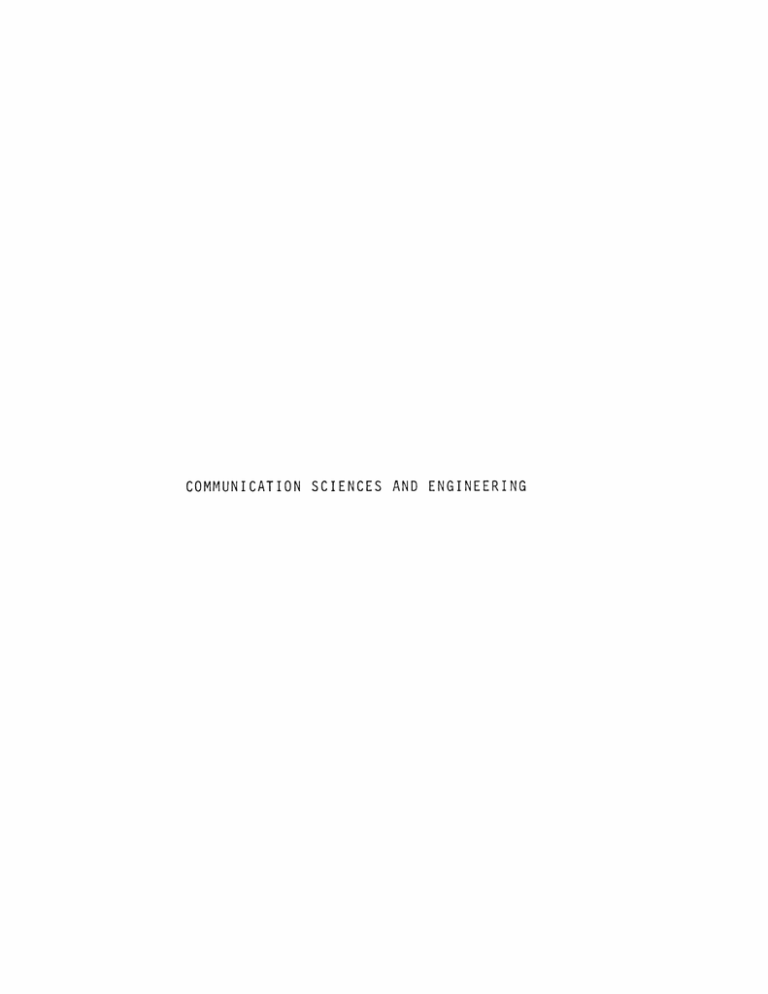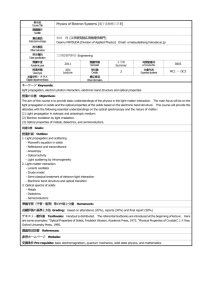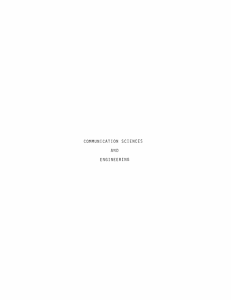COMMUNICATION SCIENCES AND ENGINEERING
advertisement

COMMUNICATION SCIENCES AND ENGINEERING XXI. OPTICAL PROPAGATION AND COMMUNICATION Academic and Research Staff Prof. R.S. Kennedy Prof. R.H. Rediker Prof. J.H. Shapiro Prof. C. Warde Dr. H.P.H. Yuen Graduate Students P.L. Bogler R.S. Bondurant J.J. Fratamico W.P. Jaeger J. Nakai T.T. Nguyen D.M. Papurt W.S. Ross R.P. Schloss The broad objectives of our programs are to determine the fundamental limits on the detection and communication performance that can be realized with important optical channels and to identify, and establish the feasibility of, techniques and devices which can be used to achieve these limits. 1. IMPROVED LOW-VISIBILITY COMMUNICATION National Science Foundation (Grant ENG78-21603) U.S. Army Research Office - Durham (Contract DAAG29-90-C-0010) Robert S. Kennedy, Jeffrey H. Shapiro, Cardinal Warde This program, part of which is carried out jointly with MIT's Center for Materials Science and Engineering (CMSE), concerns the problem of line-of-sight atmospheric optical communications under low-visibility weather conditions. During the past year substantial progress has been made in our studies of optical propagation in turbid atmospheres,1-4 communication through optical scattering channels,556 and devices and techniques for space-distributed optical-phase compensation. 6-8 The sections that follow provide an overview of our recent research results in the first two of the preceding areas; the work on phase compensation resides in CMSE. Our principal objectives for next year are (a) to begin communication-type experiments over our 7.4-km propagation range, and (b) continue to refine and extend our ability to do space-distributed phase compensation. The communicationPR No. 123 139 (XXI. OPTICAL PROPAGATION AND COMMUNICATION) type experiments will initially employ a frequency-doubled Nd:YAG laser but will evolve towards more realistic systems that might be used in practice. The second aspect of next year's program will entail further experimentation with interference phase loop systems that employ the microchannel spatial light modulator. 8' 9 This work will also include a more thorough examination of the limit set by atmospheric coherence time on the utility of phase compensation systems. 6 a. Propagation Studies During the past year we have made the transition, in our atmospheric propagation studies, from exploratory propagation measurements to the development and verification of approximate theories to predict the behavior of the low-visibility atmospheric channel. In particular, we have focused our effort on two theories, viz., the multiple-forward scatter (MFS) and the strong multiple-scatter (SMS) approaches. Both theories originate in experimentally observed channel behavior. The MFS approach (first suggested by Mooradian et al.10) is an ad hoc small-angle approximation based on a truncated single-scatter phase function. We have developed this model to the point where it can provide '5 simple yet realistic predictions for the attenuation, beam spread, angular spread and multipath spread encountered in a line-of-sight low-visibility communication link; a coherence time prediction has also been obtained from this model, but no experimental validation is available as yet. We have also explored the incorporation of a diffusionlike propagation mode into the MFS model so as to have a natural decay of MFS behavior at very large optical thickness.? The second theory we have pursued, the SMS approach, relies for its foundation on the experimentally observed insensitivity of off-axis received power to 3 At present, the SMS model is inhomogeneities in the distribution of scatterers. limited to point sources. It provides, in its present form, an analytical assess- ment of the transition to diffusion-mode propagation. For the next year we do not anticipate a major thrust in the propagation area. We will be working on the coherence time question, as it bears on the utility of phase compensation; we may also continuell an effort begun earlierl2 to reformulate the multiple-scattering problem in a manner that leads to more explicit results with relatively weak assumptions. PR No. 123 140 (XXI. OPTICAL PROPAGATION AND COMMUNICATION) b. Communication Studies The essential communication-theory features of the low-visibility channel were established some time ago. 13 ,14 These studies predate the development of realistic propagation models so they are based on ad hoc received-field statistical models. Nevertheless, the early work established two vital principles: that background-light suppression is the key to reliable low-visibility channel optical communication, and that adaptive phase compensation is an important option for achieving this suppression. Lately, we have begun reassessing the communication theory work based on the predictions of the MFS channel model. 5'6 We have found that background-light suppression is indeed vital to maintaining daytime link operability in bad weather, and have considered the merits of the three generic approaches (development of narrow-band wide-angle filters, operation at mid-ultraviolet wavelengths, and the use of adaptive phase compensation) for achieving significant background suppression. For the next year, our communication studies will be aimed at establishing a demonstration link to explore the experimental viability of some of the receiver structures we have analyzed. Theoretical work on the use of error-correcting codes for the low-visibility channel is also anticipated. References 1. J. Nakai, "A Spatio-Temporal Channel Model of Low-Visibility Optical Wave Propagation," S.M. Thesis, Department of Electrical Engineering and Computer Science, M.I.T., January 1980. 2. T.T. Nguyen, "A Combined Forward-Scatter and Diffusion Analysis of LowVisibility Optical Propagation," S,M. Thesis, Department of Electrical Engineering and Computer Science, M.I.T., August 1980. 3. W.S. Ross, "Point-Source Optical Propagation in a Multiple Scattering Medium," Ph.D. Thesis, Department of Electrical Engineering and Computer Science, M.I.T., August 1980. 4. W.S. Ross, W.P. Jaeger, J. Nakai, T.T. Nguyen, and J.H. Shapiro, "Atmospheric Optical Propagation: An Integrated Approach," to appear in Opt. Engr. 5. J.H. Shapiro, "Optical Communications through Low-Visibility Weather Conditions," 1980 National Telecommun. Conf. Record, IEEE, New York (1980), pp. 27.6.1-27.6.6. PR No. 123 141 (XXI. OPTICAL PROPAGATION AND COMMUNICATION) 6. J.H. Shapiro and C. Warde, "Optical Communication through Low-Visibility Weather," Opt. Engr. 20, 76-83 (1981). 7. C. Warde, A.M. Weiss, and A.D. Fisher, "LiNb0 3 and LiTaO 3 Michrochannel Spatial Light Modulators," Proc. SPIE 218, 59-66 (1980). 8. A.D. Fisher, "High-Resolution Adaptive Phase Compensation," Ph.D. Thesis, Department of Electrical Engineering and Computer Science, M.I.T., November 1980. 9. C. Warde and A.D. Fisher, "Adaptive Phase Compensation for Low-Visibility Optical Communication," Proc. SPIE 209, 144-151 (1979). 10. G.C. Mooradian, M. Geller, L.B. Stotts, D.H. Stephens, and R.A. Krautwald, "Blue-Green Pulsed Propagation through Fog," Appl. Opt. 18, 429-441 (1979). 11. P.L. Bogler, unpublished Ph.D. thesis research, Department of Electrical Engineering and Computer Science, M.I.T. (1980). 12. D.C. Simmons, "An Investigation of the Reciprocity of a Scattering Atmosphere," S.M. Thesis, Department of Electrical Engineering and Computer Science, M.I.T., September 1978. 13. R.S. Kennedy, "Communications through Optical Scattering Channels: An Introduction," Proc. IEEE 58, 1651-1665 (1970). 14. S.R. Robinson, "Phase Compensation Receivers for Optical Communication," IEEE Trans. Commun., COM-25, 900-909 (1977). 15. C. Warde, A.M. Weiss, A.D. Fisher, and J.I. Thackara, "Optical Information Processing Characteristics of the Microchannel Spatial Light Modulator," submitted to Appl. Opt. 2. FIBER-COUPLED EXTERNAL-CAVITY SEMICONDUCTOR HIGH-POWER LASER U.S. Navy - Office of Naval Research (Contract N00014-80-C-0941) Robert H. Rediker, Robert P. Schloss This program has as its goal the demonstration of the feasibility of coupling low-power semiconductor lasers in parallel to produce a high-average-power coherent laser beam. Such a laser system would combine the reliability of diode lasers with the higher power and monochromaticity required for several communiIn the proposed system, optical fibers from the individual low-power semiconductor lasers are gathered together to act as a source for the external cavity with an appropriate spatial filter to assure that coherence is cations applications. established over the entire optical bundle emitter. PR No. 123 142 (XXI. OPTICAL PROPAGATION AND COMMUNICATION) In the first phase of this program, the coupling of diode laser radiation into, its propagation through, and its outcoupling from fibers are being studied. Experiments are under way to combine a diode laser and a fiber inside an external cavity. 3. ATMOSPHERIC PROPAGATION EFFECTS ON INFRARED RADARS U.S. Army Research Office - Durham (Contract DAAG29-80-K-0022) Jeffrey H. Shapiro, David M. Papurt This program is aimed at obtaining a quantitative understanding of the effects of atmospheric propagation and target reflection characteristics on the performance of compact CO2 laser heterodyne-reception radars. Under a collaboration arrangement with the Optics Division of the M.I.T. Lincoln Laboratory, the experimental portions of the research are to be carried out on the compact infrared radar under development there. Since the inception of this program, progress has been made in the following areas: (i) Initial clear-weather infrared radar measurements have been collected with simultaneous scintillation and seeing data over a 1-km path; (ii) An analysis of the relative merits of linear and logarithmic frame integration of speckle and scintillation-limited imagery has been carried out; 2 (iii) A doctoral thesis aimed at extending the models to include the 3 multiple-scattering effects present in bad weather conditions has been initiated. The research plan for the next year involves: (1) reduction and evaluation of initial clear-weather (turbulence) data; (2) development of computer programs to simulate radar imagery; (3) additional data collection in a variety of turbulence conditions. References 1. J.H. Shapiro, "Linear vs Logarithmic Frame-Integration for Coherent Laser Radars," to be presented at the 1981 IEEE International Symposium on Information Theory, Santa Monica, CA, 1981. PR No. 123 143 (XXI. OPTICAL PROPAGATION AND COMMUNICATION) 2. J.H. Shapiro, "Imaging and Target Detection with a Heterodyne-Reception Optical Radar," Project Report TST-24, M.I.T. Lincoln Laboratory (Oct. 13, 1978). 3. D.M. Papurt, Ph.D. thesis research, Department of Electrical Engineering and Computer Science, M.I.T., Fall 1980. PR No. 123 144



